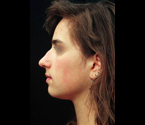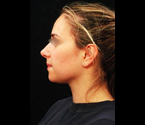Ethnic Rhinoplasty In Chicago


* Individual results may vary.
Photo Gallery
View before-and-after pictures of real patients of Dr. Laurie A. Casas
Ethnic rhinoplasty is an increasingly popular procedure patients from diverse backgrounds are undergoing to make minor adjustments to their noses. This procedure redefines aspects of the nose, without compromising the beauty of your natural ethnic features.
What is Ethnic Rhinoplasty?
Ethnic rhinoplasty is a nose job that takes into consideration the multitude of differences between various ethnic backgrounds. This procedure is geared towards improving the cosmetic appearance of the nose by reducing its size and tweaking its shape, but still keeping many of its original features intact.
Performing these procedures requires plastic surgeons to have an in-depth understanding of the natural characteristics of various ethnic groups to help redefine the nose and improve facial symmetry.
Types of Ethnic Rhinoplasty Procedures
There are two types of common ethnic nose jobs that are classified based on the technique of the procedure. Open or closed rhinoplasty techniques can be used to achieve the results desired, but each has its own advantages and disadvantages.
Open Rhinoplasty
The open technique utilizes an incision on the columella, the small flap of skin separating the nostrils, providing greater access to the nasal structures. Plastic surgeons are often able to correct more severe deformities and provide more precise corrections using the open technique. It does leave a visible scar at the bottom of the nose, however, the small scar will fade and become less noticeable over time.
Closed Rhinoplasty
The closed technique uses incisions placed inside the nostril which are not visible and thus no noticeable scar. In addition, there is often less swelling and less recovery time. However, only milder nasal issues can be addressed using this approach.
Common Nose Traits and Procedures by Ethnicity
Ethnic nose jobs can be divided into four different categories based on the ethnicity of the person undergoing the rhinoplasty. Each ethnicity tends to have similar complaints about their noses and this leads to a common group of procedures for each ethnicity to correct these issues and help redefine the appearance of the nose.
African American Rhinoplasty
An African American nose will typically have certain anatomic features that are the typical issues many patients have to correct. These include:
- A wide and flat nasal bridge
- A bulbous tip of the nose
- Nostril flaring
- Thick nasal skin
- Weak nasal cartilage
These common complaints lead to the best rhinoplasty surgeons recommending a variety of common procedures. These can include:
- Alar reductions to reduce the width of the lower third of the nose
- Elevation and narrowing of the nasal bridge
- Redefining the tip of the nose
The most complicated aspect of these procedures is to not undercorrect or overcorrect any aspects of the procedure that can ruin the symmetry of the nose. Therefore, the ethnic rhinoplasty experience of Casas Aesthetics Plastic Surgery makes it the ideal place to have these procedures done.
Hispanic and Latino Rhinoplasty
Certain anatomical characteristics commonly seen in Hispanic and Latino patients include:
- A dorsal nasal hump
- A bulbous tip of the nose
- Weak septal cartilage
- Think nasal tissues
- Wide nasal base
These characteristics can lead to the following procedures being performed based on the needs of the patient. Common procedures include:
- Redefining the tip of the nose
- Reducing the width of the bottom third of the nose
- Reducing the appearance of a dorsal hump
Dr. Laurie A. Casas utilizes her significant experience and extensive training to provide dramatic improvements without altering the beauty of the patient’s cultural heritage.
Middle Eastern Rhinoplasty
Patients of Middle Eastern ethnicity often feel their noses are too big and too droopy. This results from distinct characteristics that are commonly seen such as:
- A dorsal hump
- Underdevelopment of the bony portion of the nose between the eyes
- Elevation of the nasal bridge
- A deviated septum
- An underdeveloped tip of the nose
To correct these characteristics of the nose, many of the best ethnic rhinoplasty plastic surgeons will recommend the following procedures:
- Reducing the dorsal hump and lowering the nasal bridge
- Elevating the bony portion of the nose between the eyes
- Straightening the nose
- Redefine the tip of the nose
The goal of many ethnic rhinoplasties in Middle Eastern patients is to reduce the nose and provide a more defined appearance.
Asian Rhinoplasty
Patients of Asian ethnicity often have noses with a wider, shorter appearance with less projection. This is often due to the following characteristics:
- A low and flat nasal bridge
- Wide and bulbous tip of the nose
- Wide nostrils
- Thick skin of the nose
- Thin nasal septum
This group of characteristics often requires the plastic surgeon to perform the following procedures to alter the appearance of the nose:
- Reducing the width of the bottom third of the nose
- Elevate the bridge of the nose
- Reduce the tip of the nose and increase its definition
Restoring the overall symmetry requires understanding the complex nature of the multiple procedures to ensure each is performed correctly. The in-depth experience of Dr. Laurie Casas has played an essential role in ensuring the best outcome for her Asian patients.
Recovery from Surgery
The healing process after an ethnic nose job may change depending on the extent of the procedure and whether an open or closed procedure is performed. Additionally, everyone’s body heals at different rates so it is important to follow your surgeon’s recovery plan to ensure the best results.
However, the recovery from an ethnic rhinoplasty will take around 7–10 days, during this time it is common to experience swelling, bruising, discomfort, nausea, and nasal congestion. The nose may be wrapped in bandages and a splint. This helps to protect the nose and ensure the results are maintained directly after the procedure.
After the first week to ten days, most patients are able to return to work or school. At this point, you may be able to return to exercise and most activities, but it is important to check with your surgeon before starting any exercise.
As the swelling improves after your procedure, the results of the procedure will progressively be more visible. After three to six months, dramatic improvements in the nose will be noticeable, but it may take a full 12–18 months to appreciate the final results.
Cost of Ethnic Rhinoplasty in Chicago
The cost of an ethnic nose job in Chicago can depend on many different factors and there is a wide range in the overall costs. The main factors determining the costs include the surgeon’s experience and expertise, plastic surgeons with more experience are often in more demand and will be more expensive.
The geographical location of your surgery will also play a role in the overall cost of the procedure. Large cities, such as Chicago, will experience a much higher demand for cosmetic procedures resulting in increased costs.
During your initial consultation at Casas Aesthetic Plastic Surgery, Dr. Casas will develop an individualized approach to your nose job and provide you with the total cost of the procedure and discuss any financing options available for the procedure.
Schedule a Consultation at Casas Aesthetics Plastic Surgery
If you are unhappy with the appearance of your nose, transform its appearance while preserving your cultural identity and improving the natural symmetry of the face. Schedule a consultation at Casas Aesthetics Plastic Surgery, where you will receive extraordinary care and a personalized approach to achieving the best results.
To schedule a consultation today, call our office at 847-657-6884.
Frequently Asked Questions About Ethnic Rhinoplasty
- Injectables. Dermal fillers and botox injections can be used to smooth wrinkles to provide a more youthful appearance.
- Cheek augmentation. The use of facial fat transfers or cheek implants can help restore volume loss in the cheeks and dramatically improve your appearance.
- Chin augmentation. The addition of a chin implant and/or dermal fillers can help to improve the overall symmetry of the face after a nose job.
- Consider how many ethnic rhinoplasties the surgeon has performed. Experience performing these procedures is invaluable and often correlates with improved results.
- Inquire as to when the last time the surgeon performed this procedure. Surgeons who perform ethnic rhinoplasties relatively frequently are able to keep their skills sharp.
- Evaluate pre and post-op photos. This provides you with an idea of the results the surgeon is able to achieve before stepping foot in their office.
- Read the reviews. The reviews provide insight into how previous patients were treated and if they were satisfied.
- Make sure you feel comfortable with the surgeon. Feeling confident in the surgeon and comfortable discussing sensitive topics is essential to building a strong patient-doctor relationship.
- Refining the tip of the nose
- Removing dorsal humps
- Improving nasal symmetry
- Correct breathing issues and abnormalities
- Reduce the width of the nasal bridge
- Improving facial harmony with a more defined, attractive nose


